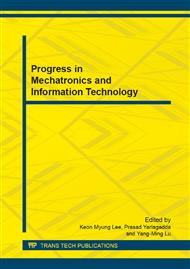[1]
Winquist F, Lundstrom I, Wide P. The combination of an electronic tongue and the electronic nose[J]. Sensors and Actuators, 1999, 58: 512- 517.
DOI: 10.1016/s0925-4005(99)00155-0
Google Scholar
[2]
Ding Naike. Food flavor chemistry [M]. Beijing: China Light Industry Press, (1996).
Google Scholar
[3]
Wang Ping. Artificial olfaction and artificial taste [M]. Beijing: Science Press, (2000).
Google Scholar
[4]
Toko K. Taste sensor [J]. Sensors and Actuators, 2000, 64: 205- 215.
Google Scholar
[5]
Vlasov Y, legin A. Cross- sensitivity evaluation of chemical sensors for electronic tongue: determination of heavy metalirons[J]. Se- nsors and Actuators, 1997, 44: 532- 537.
DOI: 10.1016/s0925-4005(97)00241-4
Google Scholar
[6]
Winquist F, Wide P. An electronic tongue based on voltammetry[J]. Analytica Chimica Acta, 1997, 357: 21- 31.
DOI: 10.1016/s0003-2670(97)00498-4
Google Scholar
[7]
Huang Gan H. Construction and preliminary application of the sensor array. PhD thesis, (2006).
Google Scholar
[8]
Constantino C J L, Dhanabalan A, Riul Jr A, et al. Surface potentials of polyaniline lb films[J]. Synthetic Metals, 1999, 101: 688- 689.
DOI: 10.1016/s0379-6779(98)00798-x
Google Scholar
[9]
Riul Jr A, Taylor DM, Mills CA, et al. Langmuir and Langmuir- Blodgett (LB) films of 4- dicyanomethylene, 4Hcyclopenta [2, 1 - b, 3, 4 - b0]dithiophene [J]. Thin Solid Films, 2000, 366: 249- 254.
DOI: 10.1016/s0040-6090(00)00743-4
Google Scholar
[10]
Sehra G, Cole M, Gardner JW. Miniature taste sensing system based on dual SH- SAW sensor device: an electronic tongue[J]. Sensors and Actuators B, 2004, 103: 233-239.
DOI: 10.1016/j.snb.2004.04.055
Google Scholar
[11]
Shi- Yi Tian, Shao- Ping Deng, Zhong- Xiu Chen. Multifrequency large amplitude pulse voltammetry: A novel electrochemical method for electronic tongue [J]. Sensors and Actuators, (2006).
DOI: 10.1016/j.snb.2006.11.011
Google Scholar
[12]
Toko K. Electronic tongue[J]. Biosensors & Bioelectronics, 1998, 13: 701- 709.
DOI: 10.1016/s0956-5663(98)00025-6
Google Scholar
[13]
Toko K, Ikezak iH. A nalysis of sake taste using multielectrode taste sensor[J]. Sens Materials, 1995, 7: 261- 270.
Google Scholar
[14]
Vlasov Y, Legin A, Rudnitskaya AM. Electronic tongue- -new analytical tool for liquid analysis on the basis of nonspecific sensors and methods of pattern recognition [J]. Sensors and Actuators, 2000, 65: 235- 236.
DOI: 10.1016/s0925-4005(99)00323-8
Google Scholar
[15]
Ivarsson P, Holmin S, Winquist F, et al. Discrimination of tea by means of a voltamm- etric electronic tongue and different applied waveforms [J]. Sensors and Actuators, 2001, 76: 449- 454.
DOI: 10.1016/s0925-4005(01)00583-4
Google Scholar
[16]
Winquist F, Soderstrom C, KrantzRu lcker. Recognition of six microbial psecies with an electronic tongue[J]. Sensors and Actua tors, 2003, 89: 248- 255.
Google Scholar
[17]
Winquist F, Holmin S. A Hybird electronic tongue [J]. Analytica Chimica Acta, 2000, 406: 147- 157.
DOI: 10.1016/s0003-2670(99)00767-9
Google Scholar


